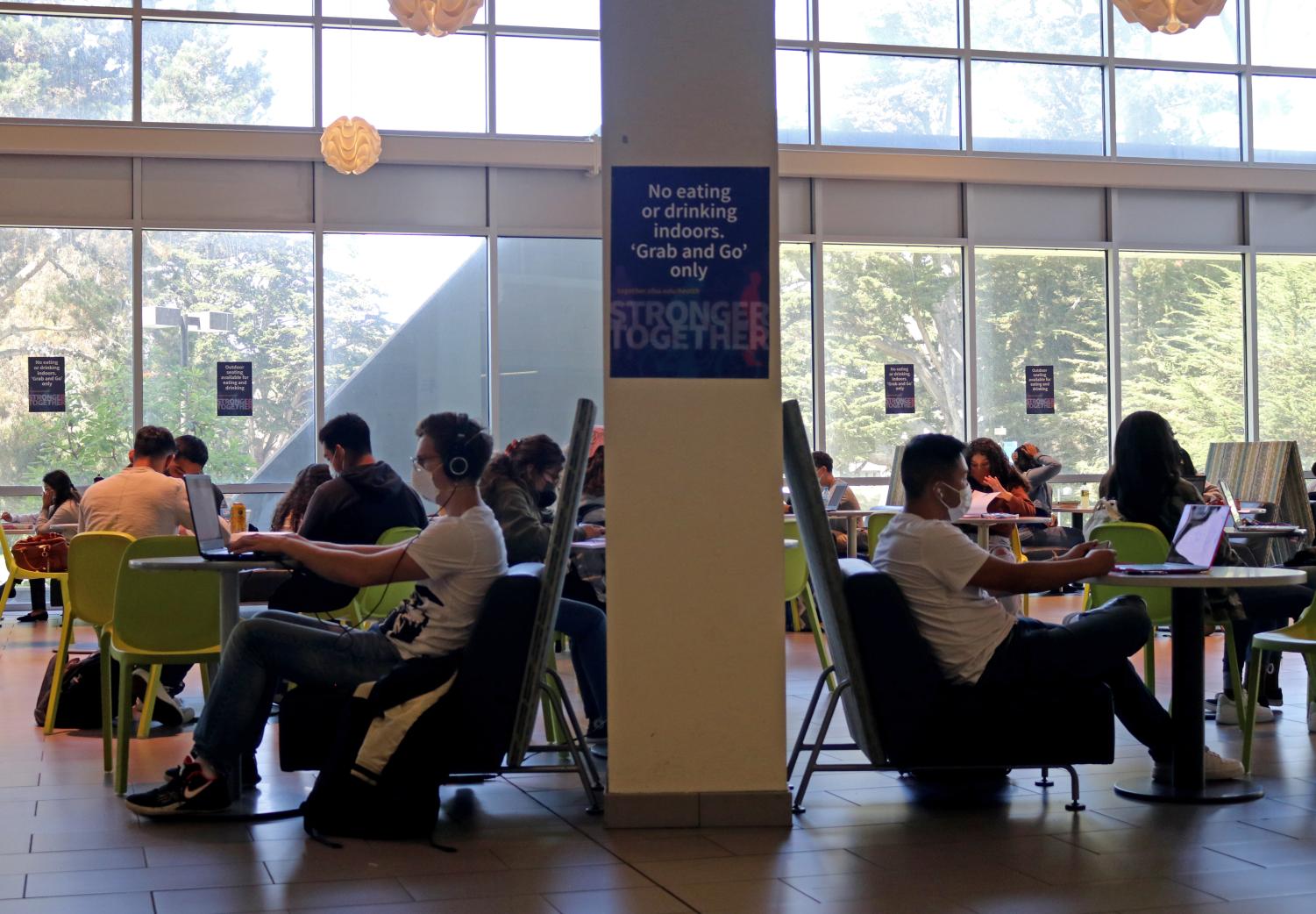



After surveying students in the Fall, faculty and individual departments tailored class offerings to meet student demand
November 20, 2021
When Bárbara Abadía-Rexach first visited campus for a job interview in February 2020, she was nervous about how she’d be received by the university.
The job to teach for the Latina/Latino Studies department within the College of Ethnic Studies was an aspirational opportunity to her, as a Black Puerto Rican woman and an anti-racist activist, but she worried about potential communication barriers between herself and her pupils in her first Afro Latinx class at SF State.
To her surprise, students were not deterred by her Spanish accent but were engaged, and her evaluation resulted in a job offer. The new associate professor’s bank account balance moderated her excitement, as did the task of finding housing and adjusting to the high cost of living in San Francisco.
“I’m kind of pessimistic, but that day I felt so optimistic,” Abadía-Rexach said of her first day on-campus.
A month later, the pandemic dashed Abadía-Rexach’s plans to relocate to SF State indefinitely. Between her mounting responsibilities at University of Puerto Rico, the U.S. territory’s unstable sociopolitical climate and caring for her family in Florida, her work at SF State was limited to teaching asynchronous online classes. While the learning modality provided flexibility in the pandemic and allowed her to build savings, Abadía-Rexach said that she was concerned with the quality of discussions in the classroom.
As SF State ramps up toward the Spring 2022 semester, administration has pushed departments to provide more in-person courses for a return to normal campus operations and to meet a growing student demand for hands-on learning. Across all departments, an average of 58% of classes will return to an in-person format next semester — about a 20% increase from the Fall 2021 semester — according to statistics from the Office of the President.
Some members of the campus community, however, have mixed feelings about the return. Some staff and students view the move as crucial for engaging with instruction and returning to a sense of pre-pandemic normalcy — albeit masks indoors are here to stay — while others have found online learning allows greater accessibility.
When the pandemic began, new and established professors alike scrambled to adapt their curriculums over the three-week transitional period in March — many feeling uncompensated for their flexibility. Many studio and lab instructors in particular questioned how to adapt hands-on classes to fit the homebound learning format.
Over the Fall 2021 semester, SF State welcomed roughly half of its student body to in-person classes, and established new health and safety regulations, limiting classroom sizes to adhere to social distancing guidelines.
In an interview with Xpress, SF State President Lynn Mahoney explained that the class modality offerings for Spring 2022 were based on the results of a student survey that was conducted in September 2021, with the goal of gathering student opinions on preferred class formats.
“We had record participation in the students’ survey, and it indicated that upper-division students and graduate students wanted more [classes] online than in-person, and lower-division, first-years and second-years, wanted more face-to-face,” Mahoney said. “So we’ve put together a schedule that attempts to do that.”
The survey garnered 9,855 undergraduate and 1,042 graduate respondents, accounting for 40% of the student body. It found that first years at SF State prioritized face-to-face classes, while other grades favored online classes as their top choice.
The majority of students from all grades and disciplines advocated for a mix of in-person and online options, and averaged two classes they’d prefer to have in person.
Classes to fulfill major requirements were of students’ highest importance to be offered in their preferred format, according to the survey data. Second-most important were labs, studios and internship opportunities offered in every format except exclusively online.
At an Academic Technology student panel hosted on Wednesday, engineering sophomore student Joyce Bulatao expressed frustration in being constrained to an online format in a tactile field.
“I am more of a hands-on learner and it’s difficult for me to watch a video demonstration of what I need to learn,” Bulatao said. “When it comes to live equipment especially, I just need to physically have it in front of me.”
With specific college survey results in mind, department chairs built their course offerings around student demand, according to Lori Beth Way, dean of Undergraduate Education and Academic Planning.
While the class schedule reflects that most departments are close to evenly split between face-to-face and online class formats, there are several exceptions.
Among the SF State departments that will be returning primarily in-person are: Theatre Arts, with 87% of classes offered in-person; Nursing, with 77% of classes in-person; Marine Science and Biology, both 68% in-person, according to listings in the class schedule.
I think that the learning that we’ve done in teaching online that I think really is going to nourish what I do face to face.
— Mario Laplante
For art professor Mario Laplante, the transition away from the materials and machinery unique to the printmaking studio was a challenge. Ahead of the fall semester, several art lecturers spent weeks chopping, correlating and curating toolkits for students to use in their projects from home.
“I think that the learning that we’ve done in teaching online that I think really is going to nourish what I do face to face,” said Laplante, who will instruct several printmaking classes fully online and one in-person in the spring.
Despite the limitations of taking a studio class online, the student evaluations of the course last semester were positive, he said. Laplante attributed this to the accessibility of information on iLearn, such as step-by-step process videos uploaded for student reference.
In addition to in-person lab offerings, online labs developed by faculty and students in the nine-week BioSLAM intensive last summer have expanded the online options for biology students, Undergraduate Biology Labs Coordinator Amber Johnson said.
“We’re really happy that we did such a rigorous program,” Johnson said. “Lots of the [online] labs are going to incorporate what we developed during the BioSLAM. [If] we have to shut down for a week or two, we’ve got this whole sort of treasure trove of labs that we’re already used to having online that we can pivot back to.”
When asked about university disaster preparedness, Mahoney stated that she does not anticipate a future COVID threat to campus operations.
Mahoney attributed the successful reopening of campus in Fall 2021, during a surge in COVID infections in the city, to high vaccination rate among in-person students, frequent testing of staff and the continued campus mask mandate.
“I would expect that [spring] is the last semester of that flexibility,” Mahoney said. “If the pandemic takes another road we’ll do something different, but assuming it’s done or winding down or it’s at a liveable level, we’ll expect folks to come back to campus.”
According to data collected by CalMatters, SF State has the highest rate of vaccinated in-person students on CSU campuses at 98%, compared to the CSU average of 95% of in-person students vaccinated. As of Nov. 19, there have been a cumulative 102 reported COVID cases on-campus since Aug. 1, 2020. This can be compared to the statewide CSU average of 224.29 reported cases. None of the COVID cases at SF State reported have been linked to a transmission on campus.
With the new wave of in-person classes comes some alterations to campus guidelines. Currently, classroom capacities rely on both maintaining six feet of social distancing and a 50% capacity maximum — the combination often resulting in less than half capacity. As a step down from this semester, Way said that the university will be able to drop the social distancing measure to allow 50% class sizes.
Research Assistant Vice President Michael Scott said that the pre-existing stock of personal protective equipment from fall is being maintained at similar levels to last semester. As part of a three-year contract, SF State will keep and maintain the 1,000 hand sanitizing stations around campus.
With the help of the Higher Education Emergency Relief Fund, SF State hired additional laboratory assistants at the start of the Fall 2021 semester to assist with regular disinfections of shared lab equipment and high-touch areas in studios, Scott said.
As with last semester, shifts in COVID-related guidelines on campus are informed by those set by the San Francisco Department of Public Health and the California Occupational Safety and Health Administration, Scott said. These guidelines include proof of vaccination status or mandatory COVID testing, as well as wellness check-ins completed via the SF State app.
“[Data shows] the virus infection is more dangerous airborne than it is on surfaces, and so they lightened up on the requirements for disinfection,” Scott said. “We’re still following what they’re recommending, but the recommendations are not as stringent as they used to be.”
Still, the university is being precautious, said Mahoney, referring to the campus mask mandate for indoor settings.
I know we can’t control the situation of each student, but we need … a balance and to be more flexible.
— Bárbara Abadía-Rexach
“Maybe I’m hopeful by the middle of the semester we’ll be in a place where we don’t need [masks] indoors all the time, but they’ll be here to stay,” Mahoney said. “We did that successfully in August. I feel really good about January, but we are going to start a campaign encouraging folks to get boosters.”
Looking beyond the Spring 2022 semester, faculty are in the process of determining what role online learning will play in the SF State ecosystem, according to Mahoney. SF State is currently exploring telecommuting options for staff to teach from home a few days per week.
For the upcoming semester, it was recommended that senior capstone courses should be offered online, allowing students in their final semester to finish their degree remotely.
“But we can’t do that forever, because we’re not a remote college,” Way said. “It would be nice if we can offer every section remote and in-person, but we just were not that fully funded.”
As for Abadía-Rexach, she is slated to continue teaching asynchronously from Puerto Rico for the spring semester, but plans on transitioning to in-person teaching next summer to fulfill her California residency requirement.
She stressed that the university should “humanize” its approach to requiring students and staff to return to the classroom, being understanding of student circumstances and limitations to in-person attendance.
“The pandemic is not over because we need transitions,” Abadía-Rexach said. “I know we can’t control the situation of each student, but we need … a balance and to be more flexible.”

